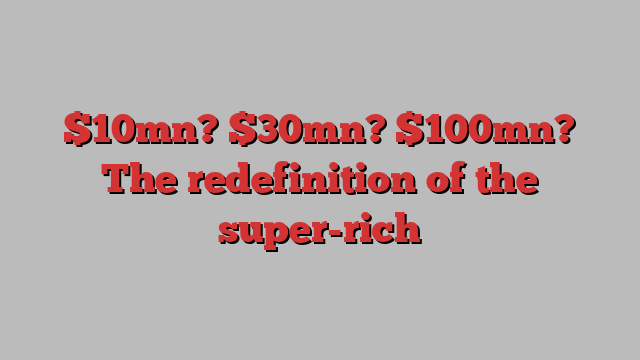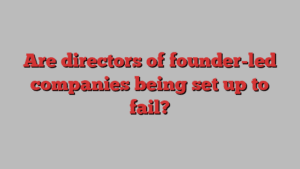
Talk to 10 different wealth industry professionals about when you become super-rich (an ultra-high-net worth individual, or UHNW, in industry parlance) and you will get 10 different answers. For a law firm, it can mean having investable assets — spare cash not tied up in property — of $10mn; for a wealth manager, it can mean having at least $30mn; for an exclusive private members’ club, the hurdle can be as high as $100mn.
What they do agree on, however, is that the base figure is rising, and quickly. The monetary definition has shifted significantly, reflecting not just the growth in wealth globally, but also the changing expectations of what it takes to be considered part of this elite group.
David Gibson-Moore, president of consultancy Gulf Analytica, says the traditional $30mn level “allows for significant investments across multiple asset classes — stocks, bonds, real estate, private equity” — while also furnishing luxuries such as private-jet travel. But, over time, as the financial world has expanded and the accumulation of wealth has accelerated in certain sectors, particularly technology, “the bar for what it means to be ultra-wealthy has risen” he observes. “The $30mn threshold . . . doesn’t carry the same weight or exclusivity it once did. In today’s world, $30mn might secure you a luxurious lifestyle but, in the realms of the ultra-rich, it’s increasingly viewed as just the starting point,” Gibson-Moore adds.
“The ultra-rich today are being measured by new standards, with some financial commentators now suggesting $100mn is the new yardstick for anyone who wants to keep their head held high at private equity parties.”
Charlie Wells, managing director of high-end property buying agency Prime Purchase, agrees: “The dial keeps ticking upwards when it comes to defining ‘UHNW’. Forty years ago, a millionaire with a Rolls-Royce may have been the epitome of wealth. But, thanks to inflation, the numbers are constantly growing. Only recently, someone worth £20mn-plus would have been considered very wealthy but now you need £50mn-plus to be truly UHNW.”
This shift is driven by several factors. First, says Gibson-Moore, is the explosion of new wealth in technology and entrepreneurship. “Over the past two decades, we’ve seen the rise of tech billionaires, cryptocurrency pioneers and venture capitalists who have amassed fortunes at an unprecedented pace,” he says. “The ability to build companies worth billions seemingly overnight has compressed the time it takes to reach UHNW status and these new wealth holders often operate in a different financial universe than the more traditional wealthy class.”
Dominic Volek, group head of private clients at Henley & Partners, which advises wealthy individuals on citizenships and residencies, says: “There has been a jump in wealth creation — and one only needs to look at the tech sector, where billionaires are now common. The diversification into asset classes like cryptocurrencies and NFTs [non-fungible tokens] has also created UHNW individuals almost instantaneously.”
If you take $30mn as the accepted definition for what it takes to be a UHNW, data from consulting group Capgemini shows the number jumped from 157,000 in 2016 to 220,000 last year.

The scope of what super-rich individuals invest in has broadened, too. It is no longer just about having a diversified portfolio; today they might have stakes in disruptive tech start-ups, sustainable ventures or even space exploration. This new frontier of investment requires much larger sums of capital and comes with greater risks — but also offers the potential for exponential returns.
Inflation in luxury assets — such as property, fine art and collectibles — also means it takes far more to maintain a lifestyle traditionally associated with super-rich status. Volek says: “$30mn just doesn’t stretch as far as it did a decade ago.”
A painting by Jean-Michel Basquiat, for example, sold for $57.3mn at an auction in 2016 then again for $85mn six years later. Likewise, the price of entry into exclusive property markets such as Monaco, Mayfair or Aspen in Colorado has soared, with the average price of a house in London’s Grosvenor Square, for example, stretching to around £20mn. The costs of maintaining private aircraft, yachts and other luxury assets have similarly grown, making it far costlier to maintain the hallmarks of ultra-wealth. Experts suggest the annual running cost of a $10mn superyacht can now easily be as much as $1.5mn.
For the owners of R360, an invitation-only private members club, it is clear what the number should be to be considered ultra-rich and eligible for membership: $100mn. Barbara Goodstein, managing partner and chair of the New York chapter of R360, which offers members exclusive investment opportunities, confidential support groups and private getaways, says: “We focus on serving centimillionaires.”
She says, at that level, they get people who are “less focused on short-term investment opportunities and more interested in becoming stewards of wealth”. Goodstein notes that the $100mn threshold has been the criteria for membership at R360 since inception in 2021. “While we don’t anticipate an increase in the near future, we recognise that the average wealth of our members has steadily increased over the past few years and is now more than $400mn.”
The age of members ranges from 28 to 84 but Goodstein adds that R360 is seeing a notable rise in younger members, “with many recently successful entrepreneurs joining in their late twenties and early thirties”.
The question that follows — irrespective of the definition — is why it is so important to the very wealthy to be classified as such. What extra doors does it open?
UHNW individuals receive significantly different treatment because of the scale and complexity of their wealth, Volek adds. “Not only do they have access to better investment opportunities and more diversified portfolios, but they also have dedicated relationship managers who look after them and are available 24/7.”
They often get access to pre-initial public offering deals, private placements and other high-return opportunities that the “broader market doesn’t even know exist”, says Gibson-Moore. For example, Stripe, a fintech payment company, has conducted several rounds of private financing, most notably raising $600mn in 2021 at a valuation of $95bn. This funding round was only available to a select group of institutional investors and the super-rich.
Lifestyle perks can vary. One of the most lavish examples seen by Samuel Wu, chief investment officer of Hong-Kong-based Tridel Capital and co-founder of Chartwell Family Partners, was a European trip given to a super-rich family by a bank in return for their custom.
“More commonly, perks include invitations to concerts, meetings with celebrities [and] successful figures as well as economic leaders,’’ says Wu. ‘‘This is a form of marketing, and these costs are often reflected in the prices being charged. One particular Swiss bank is humorously known to run its entertainment programme better than its banking.” Wu says.
On the flipside, Volek at Henley & Partners says that he also knows of banks “off-boarding” private banking clients with less than $5mn in assets because they were deemed not profitable enough to have as customers. He says it shows that size now really matters in the world of the ultra-rich and that, while the definition might still be up for debate, the level at which you can be classified as UHNW is only going one way: up.
This article is part of FT Wealth, a section providing in-depth coverage of philanthropy, entrepreneurs, family offices, as well as alternative and impact investment

